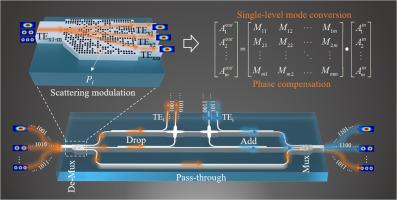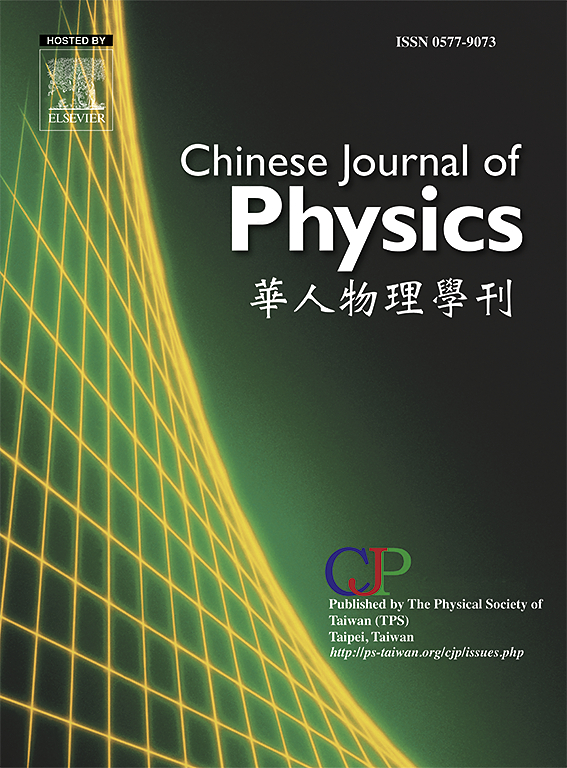Ultracompact multi-mode add-drop multiplexer based on pixelated photonic-like crystals
IF 4.6
2区 物理与天体物理
Q1 PHYSICS, MULTIDISCIPLINARY
引用次数: 0
Abstract
The development of integrated photonic systems necessitates ultracompact multi-mode add-drop multiplexers to enable high-density node interconnection communication. Conventional cascaded directional couplers, however, suffer from prolonged coupling lengths and intermodal crosstalk during the evanescent wave coupling progress, imposing fundamental limits on device miniaturization and multi-mode adiabatic conversion. Here, we propose a groundbreaking single-level mode conversion mechanism enabled by pixelated photonic-like crystals. By leveraging subwavelength-scale dielectric scattering units, we achieve simultaneous mode field confinement and phase compensation, reducing the coupling length by two orders of magnitude (to 3.6 μm × 5.4 μm) while suppressing intermodal interference. Benefiting from this design, we demonstrate an ultracompact mode add-drop multiplexer supporting simultaneous add/drop of 1-3 TE modes with the operation broadband ≥ 38 nm and insertion loss < 4 dB. Furthermore, the devices enable routing of 11.25 Tbit/s QPSK-OFDM signals with bit error rates of 10-5 at -13.5 dBm. This work verifies the feasibility of on-chip communication interconnection through the single-level mode conversion mechanism, offering a versatile solution for integrated photonic networks with potential extensions to LiDAR, quantum key distribution, and neuromorphic photonics.

基于像素化光子晶体的超紧凑多模加丢多路复用器
集成光子系统的发展需要超紧凑的多模加丢多路复用器来实现高密度节点互连通信。然而,传统的级联定向耦合器在倏逝波耦合过程中存在耦合长度延长和模间串扰的问题,从根本上限制了器件的小型化和多模绝热转换。在这里,我们提出了一种开创性的单能级模式转换机制,该机制由像素化光子样晶体实现。通过利用亚波长尺度的介质散射单元,我们实现了模场约束和相位补偿,将耦合长度减少了两个数量级(至3.6 μm × 5.4 μm),同时抑制了模间干扰。得益于这一设计,我们展示了一种支持1-3个TE模式同时添加/删除的超紧凑模式复用器,其工作宽带≥38 nm,插入损耗≤4 dB。此外,该器件能够在-13.5 dBm下路由11.25 Tbit/s的QPSK-OFDM信号,误码率为10-5。这项工作验证了通过单级模式转换机制实现片上通信互连的可行性,为集成光子网络提供了一种通用的解决方案,并有可能扩展到激光雷达、量子密钥分发和神经形态光子学。
本文章由计算机程序翻译,如有差异,请以英文原文为准。
求助全文
约1分钟内获得全文
求助全文
来源期刊

Chinese Journal of Physics
物理-物理:综合
CiteScore
8.50
自引率
10.00%
发文量
361
审稿时长
44 days
期刊介绍:
The Chinese Journal of Physics publishes important advances in various branches in physics, including statistical and biophysical physics, condensed matter physics, atomic/molecular physics, optics, particle physics and nuclear physics.
The editors welcome manuscripts on:
-General Physics: Statistical and Quantum Mechanics, etc.-
Gravitation and Astrophysics-
Elementary Particles and Fields-
Nuclear Physics-
Atomic, Molecular, and Optical Physics-
Quantum Information and Quantum Computation-
Fluid Dynamics, Nonlinear Dynamics, Chaos, and Complex Networks-
Plasma and Beam Physics-
Condensed Matter: Structure, etc.-
Condensed Matter: Electronic Properties, etc.-
Polymer, Soft Matter, Biological, and Interdisciplinary Physics.
CJP publishes regular research papers, feature articles and review papers.
 求助内容:
求助内容: 应助结果提醒方式:
应助结果提醒方式:


